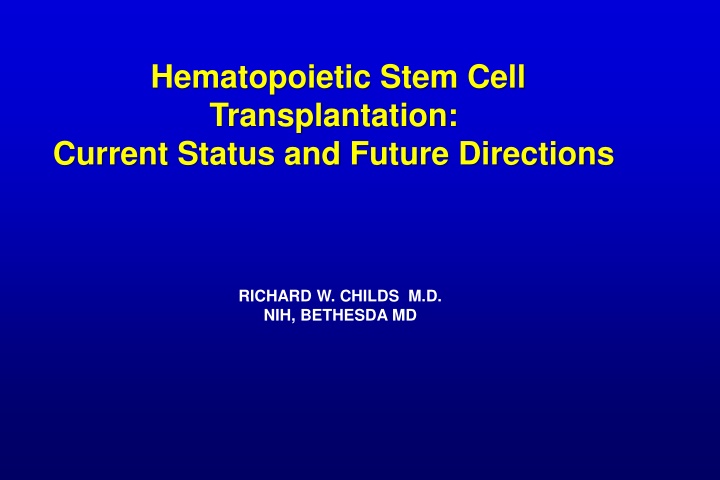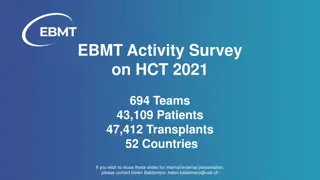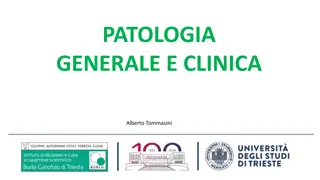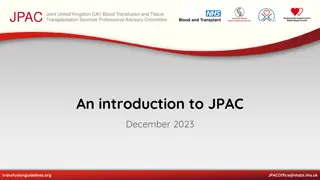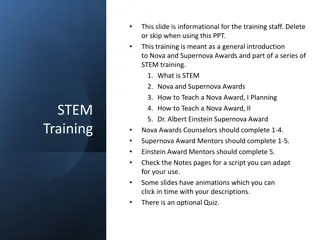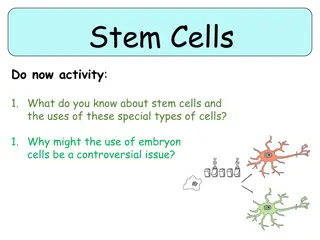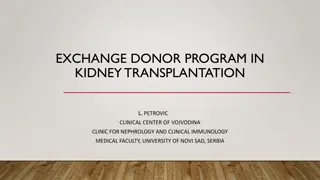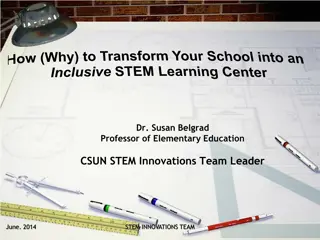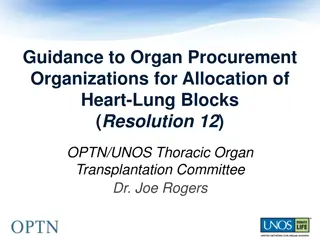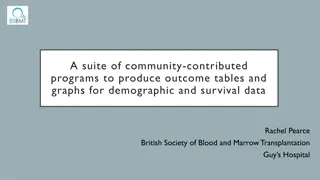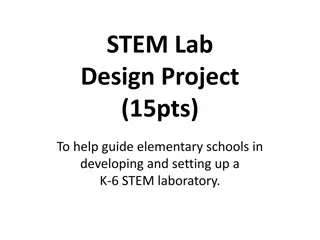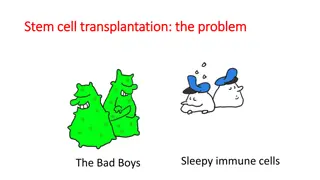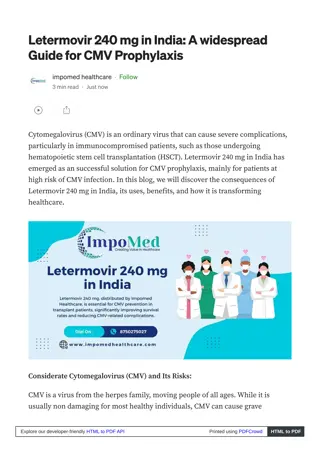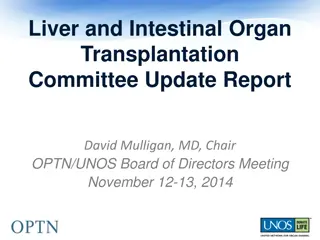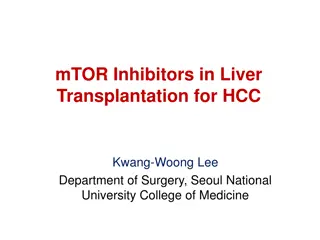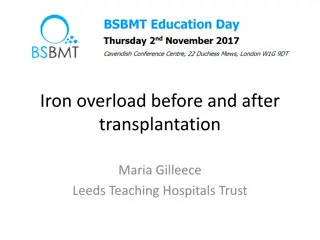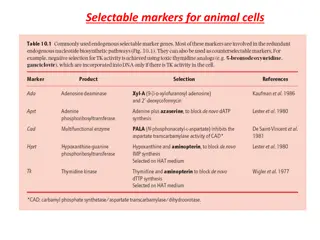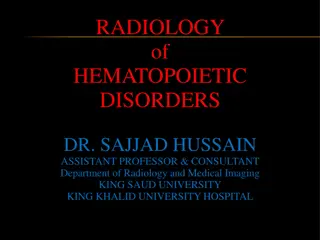Allogeneic Hematopoietic Stem Cell Transplantation Overview
This presentation discusses the current status and future directions of hematopoietic stem cell transplantation, focusing on autologous and allogeneic procedures, different sources of stem cells, and various conditioning regimens. It delves into how myeloablative allogeneic bone marrow transplantation can cure certain hematological malignancies and the types of allogeneic transplants available, including conventional and reduced intensity conditioning methods. The use of reduced intensity conditioning is on the rise, offering potential benefits for patients with refractory malignancies.
Download Presentation

Please find below an Image/Link to download the presentation.
The content on the website is provided AS IS for your information and personal use only. It may not be sold, licensed, or shared on other websites without obtaining consent from the author.If you encounter any issues during the download, it is possible that the publisher has removed the file from their server.
You are allowed to download the files provided on this website for personal or commercial use, subject to the condition that they are used lawfully. All files are the property of their respective owners.
The content on the website is provided AS IS for your information and personal use only. It may not be sold, licensed, or shared on other websites without obtaining consent from the author.
E N D
Presentation Transcript
Hematopoietic Stem Cell Transplantation: Current Status and Future Directions RICHARD W. CHILDS M.D. NIH, BETHESDA MD
Stem cell transplantation Autologous Autologous stem cell collection Freeze Stem Cells Thaw + transplant Conditioning regimen Patient First-Line Therapy:Multiple Myeloma Prolongs PFS and survival (Attal et al-NEJM-1996) Second-Line Therapy:Relapsed Hodgkin s and NHL Prolongs survival in NHL (Parma Trial-1995) Prolongs DFS in HDz (but not survival)
Stem cell transplantation Autologous Autologous stem cell collection Freeze Stem Cells Thaw + transplant Conditioning regimen Patient Allogeneic Tissue or HLA matched Allogeneic stem cell collection transplant Stem cell donor Conditioning regimen Patient
Stem Cells Source Peripheral Blood Bone Marrow Umbilical Cord Blood G-CSF subcutaneous injection for 5 days. Mononuclear cells collected by apheresis Direct aspiration under general Placental blood directly drained into bag
How Does Myeloablative Allogeneic BMT Cure? Allograft (PBSC + Lymphs) Remission T-Cells Leukemia cells GVL Transplant Day 0 Pre-transplant intensive therapy 2) Graft-vs-Tumor 1) Conditioning Regimen
Types of Allogeneic Transplants Conventional High Dose or Myeloablative Transplant Conditioning fully eradicates the hosts bone marrow Reduced Intensity Conditioning (RIC) Low dose or non-myeloablative transplant Immunologically eradicates host bone marrow
Allogeneic Hematopoietic Stem Cell Transplantation: Can Cure Patients With Chemotherapy Refractory Hematological Malignancies
Graft-vs-TumorEffects After Reduced Intensity Allogeneic Hematopoietic Cell Transplantation Can Cure 42 year female: Chemotherapy Refractory Mycosis Fungoides
T-cell Mediated Graft-Vs-Leukemia Effects Can Cure Chemotherapy Resistant Malignancies Nov 2006 7 months post transplant CSA Discontinued May 2015 9 yrs post transplant May 2006 1 month After transplant NHLBI Hematology Branch Transplant Protocol 02-H-0250
Hematological Malignancies Vary in Their Susceptibility To Graft-Vs-Leukemia (GVL) Effects Malignancy Susceptibility to GVL (response to DLI) CML chronic phase CLL Low-grade NHL AML/ALL MDS Multiple myeloma Int/high grade NHL Hodgkin s disease Refractory ALL/AML CML blast crisis High High High Intermediate Intermediate Intermediate/low Intermediate Intermediate Low Low
Most Common Indications for an Hematopoietic Cell Transplant (HCT) in the U.S. 2014 Auto: 1. Myeloma 2. NHL Allogeneic 1. AML 2. ALL 3. MDS/MPD
Allogeneic Transplant For AML in CR1 Decreases Relapse Risk and Improves Survival for Select Patients Results: - Outcomes superior for older pts with allogeneic HCT Relapse Survival >45 conv. > 45 allo > 45 allo >45 conv Stelljes et al JCO 2014:32(4
Major Improvements in Transplant Outcomes Over the Past 2 Decades Historical Problem Solution Conditioning regimens too toxic Older patients ineligible due to prohibitive risk of mortality Development of reduced intensity conditioning regimens Advent of better antifungal medications/voriconazole, PCR to detect early viral reactivation Death from invasive fungal process and CMV frequent Growth of unrelated registry, increasing use MUDS, cord transplants and haploidentical donors Lack of donors precludes the use of the procedure
REQUIRMENTS FOR ALLOGENEIC TRANSPLANTATION An HLA compatible donor to donate stem cells 25% each sibling will be HLA identical In the U.S., there is approximately a 25% that a patients will have an HLA identical sibling
Finding An Unrelated HLA Identical Donor.. A 1/10,000 chance 15 million donors in the World-Wide Registry=60% chance NMDP=National Marrow Donor Program
Likelihood of Finding an 8/8 HLA Matched Unrelated Donor Unrelated donors now more than 20 million volunteers world-wide registered Age cut-off 60 years Based on Current Donor Availability and with Recruitment Trends Extended to 2017. Gragert L et al. N Engl J Med 2014;371:339-348
Availability of a Stem Cell Sources for Allogeneic Transplantation Chances of Finding a Stem Cell Donor HLA Matched Unrelated Donor No HLA Matched Donor HLA Matched Sibling 0% 10% 20% 30% 40% 50% 60% 70% 80% 90% 100% Potential Candidates For a Cord Blood Transplant or A Haploidentical Transplant
Unrelated Cord Blood Transplantation (UCBT) Unrelated Cord Blood (UCB) transplants are a transplant option for patients lacking an HLA identical donor: - Cord blood is a rich source of Hematopoietic progenitor cells- more than human BM 60-80% of patients will have a cord unit in the public registry that could be used for a transplant Volume 25 mls Placenta Umbilical Cord Cord Blood Unit
Haploidentical BM Transplants Transplants that utilize stem cells collected from a relative who only matches for half of the HLA tissue antigens Advantages; Virtually every patient will have a haplo-identical relative to serve as a stem cell donor Disadvantages: - Higher incidence of graft versus host disease - Obligates use of T-cell depletion
Post Transplant Cyclophosphamide Following T-cell Replete Haploidentical Transplantation of BM or PBSC Fuchs E. et al JHU
Haploidentical Transplant With Post-Transplant Cyclophosphamide has similar outcome to matched unrelated transplants Survival Myeloablative Reduced Intensity Ciurea S. et al Blood 2015 126:8:1033-40
In the year 2016 Virtually every patient should have a donor stem cell source available to allow an allogeneic transplant, if indicated.
Complications of an Allogeneic Stem Cell Transplant 1. Toxicities related to the conditioning regimen - Mucosal inflammation (Mucositis) - Liver toxicity (Veno-occlusive disease) - Lung inflammation (pneumonitis) 2. Graft Rejection - occurs rarely with conventional transplants 3. Infection - bacterial/fungal: during neutropenic phase of transplant - Viral: first 100 days of the transplant Morbidity and mortality 4. Graft vs host disease- decreases relapse risk - acute: from engraftment until day +100 - Chronic: from day 100 until 2 years post transplant 5. Drug toxicities - many drugs given to prevent infection/GVHD have toxicities
Mortality is Decreasing with Allogeneic Stem Cell Transplants 60% reduction in TRM N=1418 N=1148 Bacterial, viral and fungal infections reduced Reduction in severe Grade III-IV GVHD Dramatic reduction in day 200 transplant-related mortality (TRM) and overall TRM Gooley et al; NEJM 2010: 363;22
Improving transplant outcome 100 HLA-matched sibling URD 80 One-Year Survival, percent 60 40 Better supportive care Gentler conditioning 20 Improved mgmt of GVHD 0 1988- 1990 1991 1992 1993 1994 1995 1996 1997 1998 1999 2000 2001 2002 2003 2004 2005 2006 2007 Pasquini MC, Wang Z. CIBMTR
Eligibility Status of Candidates for An Allogeneic Transplant Is In Continuous Flux Expanding: 1. Donor availability not limiting ( MUDS, Cords, Haplos) 2. Older patient age (up to 75 years with RIC) 3. Pts with medical co-morbidity eligible Contracting: 1. Some disease categories shrinking as breakthrough drugs developed a. CML effectively treated with TKI b. High-risk CLL effectively treated with BTK/PI3K inhibitors c. Eculizumab for PNH d. Immunotherapy breakthrough's (CAR CD19 T-cells)
Am I A Candidate for an Allogeneic Stem Cell Transplant?
Questions To Be Answered Does the potential benefit of a transplant justify the risk? (i.e. do I have a disease that chemotherapy can cure or make me live a long time) Is my disease controlled sufficiently to where a transplant would help? i.e. Acute leukemias should be in remission before transplant Do I Have a stem cell donor? HLA tissue matched sibling Matched Unrelated donor Cord blood or haplo-identical donor What are the chances I could be harmed by a transplant? Am I Healthy enough to go through the procedure? Am I young enough? Have prior treatments put me at increased risk for complications
Long-term Survival after HCT CIBMTR study of 10,632 allogeneic HCT recipients surviving 2 years in remission (median follow-up 9 years) Overall survival Non-relapse mortality J Wingard et al, J Clin Oncol. 2011 Jun 1;29(16):2230-9
